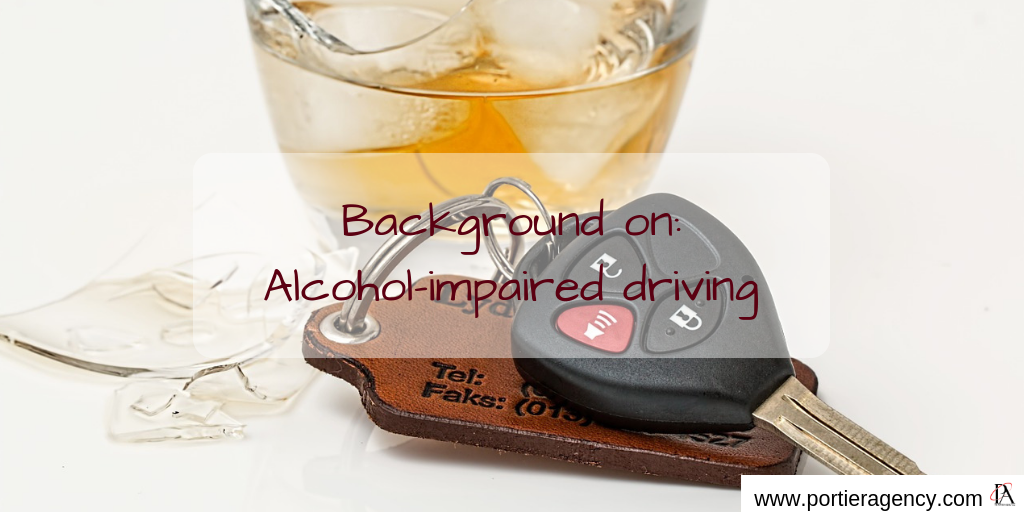Background on: Alcohol-impaired driving
Background on: Alcohol-impaired driving
Overview
Alcohol is a major factor in traffic fatalities. Based on data from the U.S. Department of Transportation, National Highway Traffic Safety Administration (NHTSA), there was an alcohol-impaired traffic fatality every 48 minutes in 2017. These crashes involve at least one driver or motorcycle operator with a blood alcohol concentration (BAC) of 0.08 grams per deciliter or above, the legal definition of impaired driving. About 10,500 people a year lost their lives in alcohol-impaired crashes between 2008 and 2017. During the same period alcohol-impaired crash fatalities accounted for about 30 percent of all crash fatalities.
Combating the alcohol-impaired driving problem
Despite significant reductions in alcohol-related fatalities in the past 30 years, progress stalled in the mid-2000s as fatalities plateaued at 10,000 lives a year lost. Organizations such as the U.S. Department of Transportation, the Insurance Institute for Highway Safety, the Governors Highway Safety Administration and Mothers Against Drunk Driving (MADD) have developed blueprints designed to prevent alcohol-impaired deaths. While about two dozen specific laws and administrative solutions have been identified, most organizations have focused on a handful of laws that have been proven to be effective in reducing fatalities involving alcohol-impaired driving.
The definition of alcohol-impaired driving was consistent throughout the United States until December 2018. All states and the District of Columbia except Utah define impairment as driving with a BAC (blood alcohol concentration) at or above 0.08 grams per deciliter. In Utah, the BAC limit was lowered to 0.05 in December 2018. In addition, they all have zero tolerance laws prohibiting drivers under the age of 21 from drinking and driving. Generally, the BAC limit in these cases is 0.02 percent. Campaigns combating alcohol-impaired driving especially target drivers under the age of 21, repeat offenders and 21-to 34-year-olds, the age group that is responsible for more alcohol-related fatal crashes than any other. Young drivers are least responsive to arguments against impaired driving, according to NHTSA.
A major tool in preventing fatalities is discouraging impaired driving which requires strong laws and enforcement. Laws that enforce the BAC level are administrative license revocation, where a driver’s license is immediately taken away if a BAC tests proves the driver’s BAC is over 0.08 grams per deciliter or the driver refuses to take a BAC test. Well-publicized programs that bring attention to the problem are important deterrents, and include sobriety checkpoints, where law enforcers screen drivers for evidence of impaired driving.
Another key tool is preventing repeat offenses. Research has underscored the danger of repeat offenders. The National Highway Traffic Safety Administration (NHTSA) has said that out of the 1.5 million arrests of impaired drivers each year, one-third are repeat offenders. Based on data for 2007, the agency said that drivers with a BAC of 0.08 grams per deciliter or higher involved in fatal crashes were eight times more likely to have a prior conviction for driving while impaired than drivers who had no alcohol in their blood. A report published in May 2010 by the American Journal of Public Health studying over 100 million driving records spanning the years 1973 to 2008 found that the recidivism rate among first offenders more closely resembles that of second offenders than of nonoffenders. This finding indicates that leniency for first offenders is not appropriate, according to the Director of Law Enforcement at the American Association of Motor Vehicle Administrators. Research collated by the National Traffic Law Center and MADD found that first offenders are very likely to have driven impaired before their first arrest. Studies found that on average, one arrest is made for every 88 instances of driving over the legal limit defining alcohol-impaired driving.
Ignition interlocks, which require drivers to blow into a breathalyzer-like device to ensure the individual is sober before allowing the vehicle to start, have been shown to reduce fatalities. The Johns Hopkins Bloomberg School of Public Health found in a report released in January 2017 that traffic fatalities declined by 7 percent in states that mandate ignition interlocks for first-time alcohol-impaired offenders. The researchers studied traffic fatalities for about five years before states began passing interlock laws in the late 1980s through 2013, when all states required them under some circumstances. The Centers for Disease Control (CDC) has studied ignition interlocks and based on the strong evidence of their effectiveness in reducing re-arrest rates recommends their use. In March 2018 the Insurance Institute for Highway Safety (IIHS) reported that that laws requiring all impaired driving offenders to install ignition interlocks reduce the number of impaired drivers in fatal crashes by 16 percent. The IIHS says that if all states adopted the most stringent laws—those that require interlocks for all offenders, including first offenders, over 500 additional lives could be saved each year. In comparison to the 16 percent of impaired drivers—including first offenders—who would be kept off U.S roads if the strictest laws were enacted, only 3 percent of impaired drivers would be kept off the road if interlocks were mandated for repeat offenders only, and only 8 percent if repeat offenders and very high blood-alcohol content impaired drivers were mandated to use the devices.
All states have laws either requiring interlocks for certain offenders or allowing courts to order interlocks at their discretion, according to the Insurance Institute for Highway Safety. In about thirty states and the District of Columbia and four California counties, all first-time offenders must install interlocks to resume driving. Most states have interlock requirements for repeat offenders. See Additional Resources and chart, State Laws Curbing Alcohol-Impaired Driving, for state-specific information on these and other laws.
Historic perspective
Awareness of the problems associated with alcohol-impaired driving increased dramatically in the 1990s in response to the rise of citizen activist groups, notably Mothers Against Drunk Drivers (MADD), and advertising campaigns and publicity efforts by organizations such as the Insurance Information Institute. Existing laws were strengthened, new laws were passed and task forces were created in several states. In addition, there was a noticeable change in attitudes toward drinking and driving.
Federal Legislation: In 1984 Congress enacted legislation that required highway construction funds to be withheld from states that did not adopt 21 as the legal drinking age for alcoholic beverages. This was the first time that federal legislation used financial incentives to persuade states to enact alcohol-impaired driving laws. The Omnibus Drug Initiative Act of 1988 (also called the Drunk Driving Prevention Act), helped to increase the adoption of the administrative license revocation law (ALR), which allows a driver’s license to be seized when his or her BAC (blood alcohol concentration) is over the level that defines driving while intoxicated or when the driver refuses to take a BAC test. It has been shown to be one of the most effective deterrents to impaired driving. Other laws enacted include those that prohibit open alcoholic beverage containers in the passenger compartments of motor vehicles, make BAC tests mandatory for drivers involved in serious or fatal accidents, prevent drivers under 21 from obtaining alcohol and provide for vehicle registration cancellation when drivers have had their licenses suspended or revoked due to alcohol-related offenses.
The 1991 Surface Transportation Efficiency Act mandated that states had to pass four out of five laws that were recognized as having the greatest effect on impaired driving: ALR laws; lowering the legal BAC limit to 0.08 grams per deciliter; using sobriety checkpoints, which remove impaired drivers from the road immediately and remind other drivers that random checks could occur at any time; establishing effective systems for preventing drivers under 21 from obtaining alcohol; and providing education programs for convicted alcohol-impaired drivers, funded by the fines assessed against those drivers. Enacting other laws brought additional funds. In 1995 the National Highway Bill further encouraged states to enact the 0.02 BAC level for drivers under 21 by holding back a portion of federal highway funds.
By the late 1990s the campaign against impaired driving focused on lowering the national limit for alcohol-impaired driving from 0.10 to 0.08 grams per deciliter BAC. The 2000 Transportation Appropriations Act mandated that states that did not enact the 0.08 grams per deciliter BAC standard would forfeit highway construction funds. By 2004 all states and the District of Columbia had enacted the 0.08 grams per deciliter BAC standard.
The Safe, Accountable, Flexible and Efficient Transportation Equity Act of 2005 included funding incentives for states that pass laws that target three types of impaired drivers: repeat offenders, drivers with BACs over 0.15 percent (“higher-risk drunk drivers”) and drivers whose licenses were previously revoked for impaired driving. It also withholds a certain percentage of funding from states that do not have an open container law (one that prohibits at least the driver of a car from having an open container of alcohol in the passenger compartment of a motor vehicle). Among the more serious penalties included for convicted higher-risk impaired drivers are[…]
###
Continue reading this Insurance Information Institute article.
Don’t forget, The Portier Agency offers:
homeowner/mobile home/ renter’s /automobile / motorcycle / life / commercial / crop insurance.
Call or come by to get your quote!
 The Portier Agency, LLC
The Portier Agency, LLC
113 North Irwin Avenue
Ocilla, GA 31774
229-468-3444
portieragency@windstream.net
